
The Amazon River in South America is the largest river by discharge volume of water in the world, and the longest or second-longest river system in the world, a title which is disputed with the Nile.
Rhinella rostrata, also known as the Mesopotamia beaked toad, is a species of toad endemic to Colombia. It is only known from its type locality near the village of Mesopotamia, on the western slope of the Cordillera Occidental in the south of the Antioquia Department.

Phyllomedusa bicolor, the giant leaf frog, bicolor tree-frog, giant monkey frog, or waxy-monkey treefrog, is a species of leaf frog. It can be found in the Amazon basin of Brazil, Colombia (Amazonas), Bolivia, and Peru, and can also be found in the Guianan Region of Venezuela and the Guianas, and in Cerrado of the state of Maranhão in Brazil.
Rhinella acutirostris is a species of toad in the family Bufonidae. It is found in Brazil, Colombia, Panama, and Venezuela. Its natural habitats are subtropical or tropical moist lowland forests, freshwater marshes, and intermittent freshwater marshes.
Rhinella cristinae is a species of toad in the family Bufonidae. It is found in La Pedrera, Amazonas Province, Colombia and possibly Brazil. Its natural habitats are subtropical or tropical moist lowland forests and rivers. It is named for Colombian amphibian collector and colleague of the discoverers, Cristina Ardila-Robayo.

The South American common toad is a species complex of toads in the family Bufonidae. They are found throughout the Amazonian South America and eastern Panama. It was originally believed to be a single species, but is now known to represent a complex of more than one.
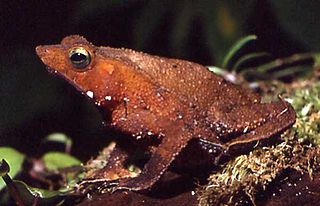
Rhinella proboscidea is a species of small South American toad in the family Bufonidae, common in the Amazon rainforest. It is the only species known to practice reproductive necrophilia.
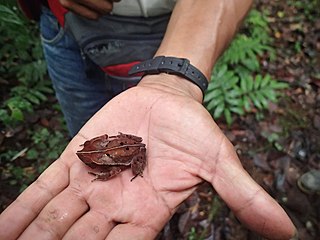
Rhinella roqueana is a species of toad in the family Bufonidae. It is found in northern Peru, eastern Ecuador (Pastaza), Amazonian Colombia, and adjacent western Brazil. Its specific name refers to its type locality, Roque, San Martín Region, Peru. Its taxonomic position is uncertain and it is not clear how to distinguish it from other members in the Rhinella margaritifera group in the area.
Rhinella vellardi, the Alto Marañon toad, is a species of toad in the family Bufonidae that is endemic to Peru. It is only known from the type locality in the upper Marañón area, Cajamarca Region of northern Peru. Its natural habitat is montane forest in the upper Amazon basin. It is a rare species of which little is known.
Rhinella lindae is a species of toad in the family Bufonidae. It is endemic to Colombia and known from its type locality, Murri in the municipality of Frontino, and from Las Orquídeas National Natural Park, both on the western slope of the Cordillera Occidental, Antioquia Department. The specific name lindae honors Linda Trueb, an American herpetologist. However, common name Murri beaked toad has been coined for this species.
Rhinella ruizi is a species of toad in the family Bufonidae. It is endemic to the Cordillera Central in Antioquia, Colombia. The specific name ruizi honors Pedro Miguel Ruiz-Carranza, a Colombian herpetologist.
Hyloxalus faciopunctulatus is a species of frog belonging to the family Dendrobatidae. It is endemic to Colombia and is specifically found in its type locality, Puerto Nariño, located in the Amazonas Department near the Peruvian border. It is likely to be found in Peru and Brazil.
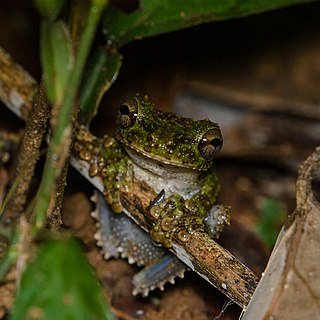
Osteocephalus cabrerai is a species of frog in the family Hylidae. It is found in the Amazon Basin in Brazil (Manaus), northeastern Peru, Ecuador, Colombia, Guyana, and French Guiana, possibly wider. Some earlier records refer to Osteocephalus buckleyi.

Osteocephalus yasuni is a species of frogs in the family Hylidae. It is found in the upper Amazon Basin in southern Colombia, Ecuador, and northeastern Peru at elevations of 70–250 m (230–820 ft) above sea level. The specific name yasuni refers to the Yasuni National Park where its type locality is.
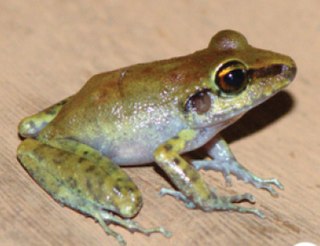
Pristimantis zimmermanae is a species of frog in the family Strabomantidae. It is found in the Amazonian Basin with records from Colombia, Bolivia, and Brazil. Its natural habitats are tropical moist lowland forests, also occurring in secondary and degraded habitats. It is a common species.

Kawall's amazon, also known as the white-faced amazon, white-cheeked amazon or Kawall's parrot, is a relatively large species of parrot in the family Psittacidae. It is endemic to the south-central Amazon. After not having been recorded in the wild for around 70 years, the species was rediscovered in the 1980s.

The violaceous jay is a species of bird in the family Corvidae, the crows and their allies.
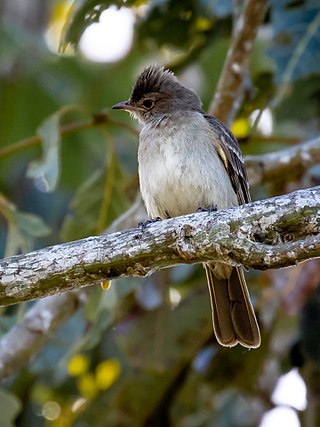
The brownish elaenia is a species of bird in the family Tyrannidae, the tyrant flycatchers. It is found along the Amazon Basin rivers of Brazil; also northern Peru and the adjacent border of Colombia; also Bolivia. The rivers are the Xingu, Iriri, Madeira, and Juruá of Brazil, and the Marañón of Peru. Its natural habitat is subtropical or tropical moist lowland forests.

Ranitomeya amazonica is a poison dart frog in the genus Ranitomeya. It was first described by Rainer Schulte in 1999 as Dendrobates amazonicus when he separated it from Dendrobates ventrimaculatus, primarily on the basis of call characteristics. The validity of the species has been debated, but further studies, also including genetic data, support its validity.
Osteocephalus castaneicola is a species of frog in the family Hylidae. It is found in lowland Amazonia of northern Bolivia, adjacent southeastern Peru, and western Brazil. It breeds in water-filled fruit capsules of the Brazil nut, a characteristic also alluded to in its specific name castaneicola derived from the Latin castanea, the root of the vernacular name castaña for the Brazil nut, together with the Latin colō meaning "to inhabit".












